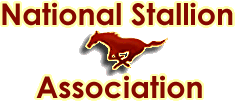

|
GUIDELINES FOR VETERINARY INSPECTION OF STALLIONS BY BODIES AFFILIATED TO THE NATIONAL STALLION ASSOCIATION (NaStA) OBJECT: The object of the examination is to exclude stallions which may pass on veterinarily undesirable traits. Allowance may be made for obvious or provable injury. The examination will be carried out using a similar procedure to the five stage examination for purchase. APPEALS: In the event of dispute or doubt concerning the examination by the original Veterinary Surgeon, the stallion may be referred by the original veterinary surgeon to a recognised * centre of excellence of the stallion owner's choice for a second opinion. This second opinion will be the financial responsibility of the stallion owner and its result will be binding. STATIC INSPECTION CONFORMATION: General appearance is a matter for the breed society; detailed conformation is a matter for the Veterinary Surgeon. HEAD
THROAT There should be no signs of operation for wind defects. LIMBS There should be no evidence of limb or foot abnormalities and/or disease likely to compromise the performance of offspring. GENITALIA Both testicles should be of normal texture, freely mobile and correctly orientated within the scrotum. There should be no evidence of inguinal or scrotal hernia. BODY There should be no evidence of umbilical hernia. MOVING INSPECTION IN HAND: Movement will be studied at walk and trot, turning and backing. The stallion will be examined for locking patella, stringhalt, shivering and wobbler disease. Any lameness will be investigated for cause. LUNGEING OR UNDER SADDLE: Movement will be studied at canter. The stallion will be examined for evidence of laryngeal hemiplegia. Any lameness will be investigated for cause. NOTE: AT THE EXAMINING VETERINARY SURGEON'S REQUEST, SPECIAL TECHNIQUES SUCH AS ENDOSCOPY, RADIOLOGY OR HAEMATOLOGY MAY BE USED IF THOUGHT NECESSARY TO FULFIL THE PURPOSE OF THE EXAMINATION. Although this protocol is extensive it is not exclusive. The examining Veterinary Surgeon may bring to the attention of NaStA any condition displayed by the stallion which in his or her opinion may conflict with the purpose of the examination. PREPARATION The stallion should be well handled and capable of being lunged and having his feet picked up. Dangerous or badly behaved stallions will have their examination discontinued. * A list of centres of excellence will be provided by BEVA. |